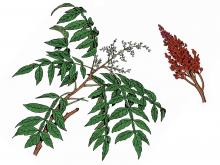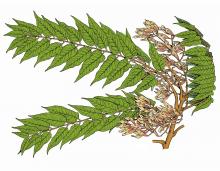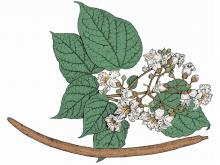Trees, Shrubs and Woody Vines
Media

Species Types
Scientific Name
Rhamnus cathartica
Description
You might see common buckthorn for sale at a nursery, but don’t buy it! At least six states have banned this invasive exotic, and the difficult-to-control plant is causing problems here in Missouri, too. Learn how to identify it — and avoid it!
Media

Species Types
Scientific Name
Corylus americana
Description
American hazelnut is a thicket-forming shrub that grows to about 10 feet high. It is prized for its edible nuts, which are covered by a distinctive leafy or papery, jagged-edged bract.
Media

Species Types
Scientific Name
Rhus copallinum
Description
Winged sumac is most common south of the Missouri River. The "wings" in the name refer to the narrow, flattened leafy structures running along the central stems of the compound leaves.
Media

Species Types
Scientific Name
Ailanthus altissima
Description
Tree-of-heaven is a fast-growing exotic that is common in urban areas. It is weedy and aggressive and should not be planted. It has 2-foot-long feather-compound leaves. Twigs smell unpleasant when you break them.
Media

Species Types
Scientific Name
Rhus spp.
Description
Sumacs are shrubs or small trees that often form colonies from their creeping, branched roots. The foliage usually turns brilliant shades of red in early autumn. The clusters of berrylike fruits are red.
Media

Species Types
Scientific Name
Catalpa speciosa
Description
Of the three species of catalpas in our state, northern catalpa is the only one native to Missouri (specifically, the Bootheel region). It has been planted widely, though, and has naturalized in many places. A popular ornamental and shade tree with pretty, orchidlike flowers and long, beanlike fruit.
Media

Species Types
Scientific Name
Quercus palustris
Description
Pin oak is one of the easiest trees to recognize by its shape alone: It has a tall, straight trunk, an overall pyramidal or conical shape and, most notably, the branches on the lower third of the tree angle downward.
Media

Species Types
Scientific Name
Toxicodendron radicans
Description
Poison ivy is a toxic plant that contains an oil in all its parts that, if you come into contact with it, can cause an intense skin reaction. Learn to recognize it, and sidestep it on your outings.
Media

Species Types
Scientific Name
Ceanothus americanus
Description
A very small shrub of our native prairies and other open sites, New Jersey tea was used by patriotic American colonists as a substitute for black tea imported from England during the Revolutionary War.
Media

Species Types
Scientific Name
Physocarpus opulifolius
Description
An attractive shrub with wide-spreading, graceful, recurved branches and bark peeling off in conspicuous thin strips, ninebark is found throughout southern and eastern Missouri on gravel bars, rocky stream banks, and bluffs along streams. It's very popular as a native landscaping shrub, too.
See Also
About Trees, Shrubs and Woody Vines in Missouri
There are no sharp dividing lines between trees, shrubs, and woody vines, or even between woody and nonwoody plants. “Wood” is a type of tissue made of cellulose and lignin that many plants develop as they mature — whether they are “woody” or not. Trees are woody plants over 13 feet tall with a single trunk. Shrubs are less than 13 feet tall, with multiple stems. Vines require support or else sprawl over the ground.





















